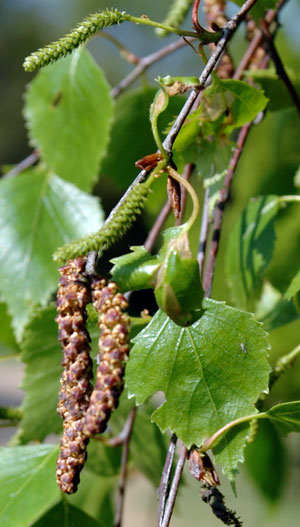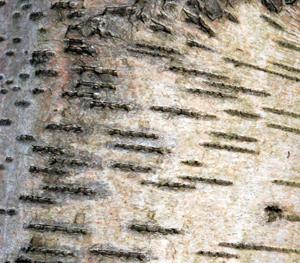Birch trees and their products.

Hazels, alders, and hornbeams belong to the Birch family - the Betulaceae. The white birch, silver birch has the scientific name Betula pendula. The birch is the national tree of Finland. As trees go, it has a rather slender, delicate form, and may be seen swaying in the wind. Its silvery / white bark develops blackened fissures with age. Early in the year it forms flowers, the male flowers in the form of catkins. The female flowers become a dark red colour after pollination, eventually forming small, wind dispersed, winged seeds.
The male catkins release large quantities of pollen (before the leaves emerge). This pollen is the dominant tree pollen in Northern Europe (in Spring).  It is often implicated in allergic responses such as rhinitis (runny nose / sneezing) and asthma.
It is often implicated in allergic responses such as rhinitis (runny nose / sneezing) and asthma.
Birch is a pioneer species, it can colonise open spaces, and disturbed ground quickly. It grows fast and once established, it helps ‘protect’ or shelter slower growing species, like Oak. It has a limited life span, perhaps a maximum circa 70 years and then gives way to longer lived species such as Oak and Beech. The tree can provide a home or food for many species of insect, woodpeckers may nest in the trunks and other birds may feed on its seeds.
The tree is quite susceptible to the honey fungus, which is the name given to several species of the fungus Armillaria. The fungus attacks and kills the roots of a number of trees and shrubs. One symptom of honey fungus is a white fungal ‘layer’ between the bark and wood, often at ground level. Clumps of honey-coloured mushrooms sometimes appear briefly on infected stumps in Autumn.
The birch tree has had many uses over the years, some dating back to the neolithic period. It has been used to make perfumes, adhesives, and besom brooms. Bundles of birch twigs were used for corporal punishment, and the twigs may be available in saunas to stimulate blood flow in the skin!  The wood of the tree is used in furniture making, creating veneers and in wood turning. However, it is the bark and sap that have attracted most interest and have many uses. Slabs of the bark are used as roofing shingles, and strips of it were / are used to make bast shoes and in handicrafts. The bark has been used in tanning, and when heated a resin forms which can act as a waterproof glue.
The wood of the tree is used in furniture making, creating veneers and in wood turning. However, it is the bark and sap that have attracted most interest and have many uses. Slabs of the bark are used as roofing shingles, and strips of it were / are used to make bast shoes and in handicrafts. The bark has been used in tanning, and when heated a resin forms which can act as a waterproof glue.
In Spring, large quantities of sap rise up the stem(s) of the tree and this can be tapped. The sap is best collected in early Spring as, if collected later, it tends to have a somewhat bitter flavour. Birch sap contains sugars, amino acids and minerals (e.g. manganese), it may be drunk fresh or fermented. Bottled birch water is available online.
In recent times, attention has focused on wood pulp from birch. It is a rich source of plant sterols and stanols.  Sterols and stanols are naturally occurring substances that have a chemical make up that is similar to cholesterol. They are found naturally in small quantities in vegetable oils, legumes, seeds, nuts, legumes, grains, and vegetables. Back in the 1950’s, they were found to lower cholesterol levels in the body, if eaten in large enough quantities. One called beta β-sitosterol was particularly effective in reducing the absorption of cholesterol from the intestines. However, there was the problem of finding a rich enough source of these compounds. This was ‘solved’ when it was found that wood pulp could yield the compounds in quantity. Now margarine-like spreads, milks and yoghurts are available that contain β-sitosterol or similar stanols in sufficient quantity to effect a lowering of blood cholesterol levels. β-sitosterol has also been to improve urinary flow in men with prostate enlargement.
Sterols and stanols are naturally occurring substances that have a chemical make up that is similar to cholesterol. They are found naturally in small quantities in vegetable oils, legumes, seeds, nuts, legumes, grains, and vegetables. Back in the 1950’s, they were found to lower cholesterol levels in the body, if eaten in large enough quantities. One called beta β-sitosterol was particularly effective in reducing the absorption of cholesterol from the intestines. However, there was the problem of finding a rich enough source of these compounds. This was ‘solved’ when it was found that wood pulp could yield the compounds in quantity. Now margarine-like spreads, milks and yoghurts are available that contain β-sitosterol or similar stanols in sufficient quantity to effect a lowering of blood cholesterol levels. β-sitosterol has also been to improve urinary flow in men with prostate enlargement.
Comments are closed for this post.

Very interesting article
angela pegg
20 September, 2023